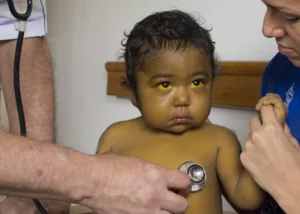The biopsy performed on the liver is a process by which the specialist extracts a sample of the organ so that it can be subjected to different studies and obtain a diagnosis. In the medical world there are different types of biopsie. In each one the doctors take the sample in different ways due to a specific intention.
First of all we have the percutaneous liver biopsy, in which the doctor uses a needle in the upper abdomen and obtains a small extract of liver tissue. This is the most common type of biopsy on the liver, in fact, it is practically a routine test. And an ultrasound or computed tomography (CT) scan may be done to make sure the needle is in the right place.
Among others is transjugular liver biopsy, which involves the inoculation of a needle into the jugular vein (located in the neck). The specialist passes the instrument through the veins until it reaches the organ, where a small sample is taken.
This type of biopsy is mainly performed in those patients who could have complications with the percutaneous type. Some cases are people who have blood clotting difficulties since they could have excessive bleeding after the procedure.
The same happens with people who suffer from cirrhosis, who have an accumulation of liquid in the abdomen and this makes access to the liver difficult. In addition, the transjugular type allows doctors to measure the pressure in the veins of the liver.
There is also the surgical liver biopsy. Which is done in the operating room and when the requirement for the biopsy coincides with a surgical intervention.
Why is a liver biopsy performed?
Everything will depend on the case, situation and needs of the patient because it can be done to diagnose diseases when this cannot be done through other studies.
As well as determining how serious the hepatic lesion is, it can also be used to improve treatment or to verify if it is evolving as expected. In order to know what will happen during the procedure and recovery, it is necessary to consult a physician. In this same consultation it is necessary to discuss allergies, present conditions and medications, whether prescribed or not.
It is possible that the doctor will request blood tests, imaging or other tests that will clarify the steps to be followed for the intervention. At the same time, you will be instructed to fast during the hours prior to the biopsy, although these indications vary, so it is necessary to follow what the specialist assigns.
What to expect after a liver biopsy?
After the biopsy has been performed, the person accompanying or responsible for the patient will receive the pertinent indications for care. This may change depending on the type of biopsy, and what the patient requires.
Generally, rest is advised and heavy lifting is prohibited for at least one week. After the sample is removed, the pathologist checks it under a microscope and the results are delivered a few days later.
Like any medical procedure, liver biopsies may also have complications such as internal bleeding, severe pain, infection, collapsed lung, pooling of blood in the space between the lung and chest wall or injury to other organs.
Most of the complications are unlikely to occur and protocols are in place in case they do occur.














